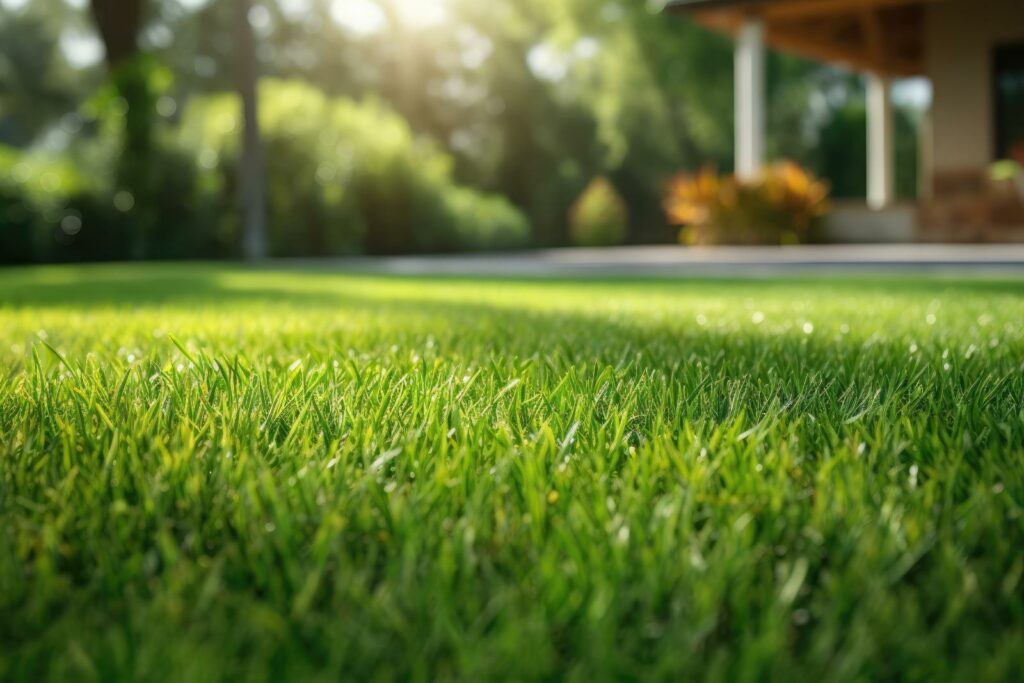
Contents
Imagine stepping out onto your lush, green lawn on a warm summer morning, the dew glistening on the blades of grass.
To maintain a healthy and vibrant lawn throughout the summer months, it’s essential to implement the top three lawn care tips.
These tips will ensure your grass stays green and resilient during hot weather and provide a welcoming outdoor space for your family and friends to enjoy.
Key Takeaways
- Regularly mow the grass every 5-7 days to maintain the optimal height
- Deep and infrequent watering of 1-1.5 inches per week, preferably in the early morning or late evening
- Use a balanced fertilizer with the correct N-P-K ratio in early summer for optimal growth
- Implement weed management strategies such as regular inspection, pre-emergent herbicides, and post-emergent herbicides
Proper Mowing Techniques
To maintain a healthy and lush lawn, it’s crucial to employ proper mowing techniques that promote strong root growth and overall grass health. Mowing frequency plays a significant role in the well-being of your lawn. It’s essential to mow regularly but not too frequently. Ideally, you should mow your lawn often enough to maintain a consistent height, typically removing no more than one-third of the grass blade at each mowing. This usually means mowing every 5-7 days during the peak growing season.
Another critical aspect of proper mowing is setting the blade height at the correct level. The ideal blade height varies depending on the type of grass in your lawn, but a good rule of thumb is to keep the grass relatively tall. Taller grass promotes stronger root systems, providing more surface area for photosynthesis and allowing the grass to produce more energy for root growth. For most grass types, a mowing height of 3-4 inches is recommended. However, it’s essential to adjust this based on the specific requirements of your grass variety.
Maintaining the proper mowing frequency and blade height is crucial for the overall health of your lawn. It promotes deep root growth, which helps the grass withstand drought and other environmental stresses. By following these mowing techniques, you can ensure your lawn remains healthy, green, and vibrant throughout summer.
Effective Watering Practices
When maintaining your lawn during the summer months, it is essential to implement effective watering practices to ensure the health and vitality of your grass. Proper watering promotes a lush and green lawn and strengthens the roots, making your grass more resilient to heat and drought stress. Here are some expert tips for watering your lawn effectively:
Effective Watering Practices
Implementing the right watering frequency is crucial for the overall health of your lawn. Overwatering can lead to shallow root growth and increase the risk of diseases, while underwatering can result in dry, brown patches. A deep and infrequent watering schedule is recommended to encourage your grass to develop deep roots, making it more resilient to harsh summer conditions.
| Watering Frequency | Time of Day | Signs of Proper Watering |
|---|---|---|
| 1-1.5 inches per week | Early morning or late evening | Even soil moisture, slight wilting before watering |
| Adjust based on rainfall | Avoid watering during midday | Healthy, deep green color |
Appropriate Fertilization Methods
Consider carefully selecting a balanced fertilizer specifically formulated for the needs of your grass to promote healthy growth and development. When it comes to appropriate fertilization methods, understanding the specific needs of your lawn is crucial. Using a balanced fertilizer that contains a mix of nitrogen, phosphorus, and potassium will help ensure that your grass receives the necessary nutrients for optimal health. Look for a fertilizer with a nitrogen-phosphorus-potassium (N-P-K) ratio that’s suitable for your grass type and the current season.
Organic options can be a great choice for fertilizing your lawn during the summer. Organic fertilizers release nutrients slowly, providing steady and consistent nourishment for your grass. They also improve the soil structure and encourage microbial activity, contributing to overall lawn health. Look for organic fertilizers that contain natural ingredients such as compost, bone meal, or kelp meal. These can provide a rich source of nutrients for your grass without the potential negative environmental impacts associated with synthetic fertilizers.
Regarding seasonal timing, it’s essential to fertilize your lawn at the right time during the summer. Early summer is an ideal time for fertilization, as it supports the grass’s growth during the warmer months. However, be cautious not to fertilize during periods of drought or extreme heat, as this can harm the grass. Always follow the instructions on the fertilizer packaging and consider seeking advice from local lawn care professionals for specific recommendations tailored to your region. Choosing the right fertilizer and applying it at the appropriate time can effectively promote healthy grass growth and development during the summer months.
Wrap-Up
Remember that a well-maintained lawn is a healthy lawn. As the adage goes, ‘A stitch in time saves nine,’ so by following these top 3 summer lawn care tips, you can ensure your grass remains healthy and vibrant throughout the summer months.
Proper mowing, effective watering, and appropriate fertilization are key to maintaining a lush and green lawn. Follow these expert tips for a beautiful and thriving lawn all summer long.
Recent Posts
Transform Your Lawn With Local Fertilization Experts
Imagine your lawn as a blank canvas, waiting for the right brushstrokes to bring it
Top 3 Tips for Local Lawn Fertilization
Understanding your soil type, choosing the right fertilizer, and establishing a consistent fertilization schedule are
Essential Seasonal Treatments for Vibrant Lawns
In spring, your lawn may show signs of stress from winter’s harsh conditions, making it